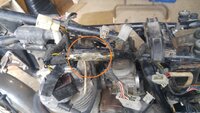LeBouc
XS400 Member
Hi!
According to the electric diagram, there supposed to be a diode somewhere in the path of the connection between the alternator and the head light relay. Anybody had problem with a blown one? I have checked the connectivity between the plugs on both side of this diode and it doesn't go through! That would be the reason for the headlight to not light at all (unless I plug the + from the battery directly to the blue/black wire that goes to the high/low switch).
If you ever had this issue, can you tell me where is sitting this diode?
Thanks
According to the electric diagram, there supposed to be a diode somewhere in the path of the connection between the alternator and the head light relay. Anybody had problem with a blown one? I have checked the connectivity between the plugs on both side of this diode and it doesn't go through! That would be the reason for the headlight to not light at all (unless I plug the + from the battery directly to the blue/black wire that goes to the high/low switch).
If you ever had this issue, can you tell me where is sitting this diode?
Thanks

